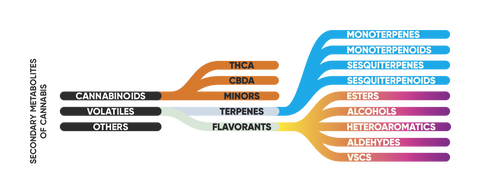Cart is empty
0 Products
FREE DOMESTIC SHIPPING OVER $100. MADE BY NATURE. PERFECTED BY SCIENCE.
FREE DOMESTIC SHIPPING OVER $100.
Cart is empty
0 Products
Part 1 of our Science of Exotics anthology covered the major findings in our white paper, The Science of Exotic I: The Dawn of Flavorants. We discussed how the role of terpenes has been overemphasized in cannabis aroma, how flavorants are responsible for the unique flavors within cannabis, and more.
In Part 2, we dove into the details of The Science of Exotic II: The Curious Case of Chem. If you’re into the savory, funky, and even chemical aromas of varieties like Chemdawg and GMO, you’ll want to check that out ASAP.
Today, we’re heading to the tropics. In The Science of Exotic III: The Trio of Tropicanna, we’re revealing the groundbreaking compounds that ACTUALLY create those juicy “tangie” aromas (Spoiler: it’s not d-Limonene).
Discover the tropicannasulfur trio responsible for the aroma of your favorite tropical cultivars.
While our understanding of the cannabis plant has come a long way, we still have so many questions. Like why do Dogwalker OG, Tropicana Cookies, and Purple Punch smell VERY different but also have similar terpene concentrations? What’s responsible for the savory and/or chemical aromas of some cannabis varieties?
Questions like these are what prompted our Science of Exotic research. In collaboration with 710 Labs, a leading cultivation and extract company, and analytical instrument experts, SepSolve Analytical and Markes International, we set out to fill some of the gaps in our cannabis knowledge.
Qualitative data from a sensory panel and quantitative data from 2-dimensional gas chromatography (GCxGC) were gathered and compared. This helped us see that similar to the way that classifications like indica and sativa no longer accurately describe the spectrum of cannabis effects, terpenes may no longer provide the necessary chemical information to differentiate varieties in regard to aroma.
Enter, flavorants. These non-terpene compounds (esters, volatile sulfur compounds, heterocycles, alcohols, etc.) are generally found in very low concentrations, and we now know these compounds are truly responsible for the diverse flavors and aromas of cannabis.

Figure 1. Schematic illustrating the wide spectrum of cannabis aromas reported from a sensory panel for multiple cultivars. The numbers in parenthesis are each variety’s Exotic Score that indicates how exotic the cultivar is. Higher numbers indicate the variety was ranked to be sweet or fruity, while lower numbers indicate the varieties were ranked as not sweet or fruity. The numbers do not correspond to quality - meaning a higher number is not better than a lower number, rather just aromatically different.
From there, we set out to identify the compounds responsible for the savory, funky, and/or chemical aromas of varieties like GMO and Garlic Cookies. After thoroughly analyzing our ice hash rosin samples, we identified two flavorants that, although found in very small amounts, have a significant impact on these aromas. Skatole and Indole.
We couldn’t stop there, though. Now, we’re uncovering which compounds help create the citrus, “tangie-like” aroma of cultivars falling near the sweet end of the aroma spectrum.
Cannabis lovers of decades past may have laughed in disbelief at names like “Papaya Peach” or “Starburst.” Today, extensive hybridization allows breeders to cultivate varieties with an astounding array of aromas, flavors, and effects. It’s important to note, however, that the paths through which distinct aroma traits have been developed and propagated in the cannabis gene pool are complex and varied.
Pungent citrus and tropical notes may have first started to be expressed in cannabis in the 1980s with Cali Orange or Cali-O. As a parent of the iconic Tangie cultivar, with its distinctive citrus scent, this makes sense. On the other hand, Tangerine Dream made its debut in the 1990s. While the scent profiles of Tangie and Tangerine Dream are similar, they don’t share a direct genetic lineage.
See what we mean? It’s complicated. One thing is for sure, though. People love cultivars with sweet, tropical, citrus, or even ripe (borderline rotten) fruit notes. This includes Tangie-like cultivars such as Mimosa, Tropicana Cookies, and Starburst with their deep, rich citrusy aromas.
But the questions remain. How does cannabis, a plant known for smelling dank and skunky, produce aromas like citrus, orange, guava, passionfruit, and even papaya? Do terpenes like d-Limonene play a role in this distinct aroma?

Figure 2. Sankey diagram showing the phytochemical makeup of cannabis.
Through the use of our complex analytical suite, we identified and quantified the myriad of different compounds in our ice hash rosin samples. Most analytical labs only test for 30 to 40 compounds in cannabis. Considering that we’ve identified over 500 distinct compounds contributing to cannabis aroma, it’s not surprising that it’s taken us four decades to discover Tropicannasulfurs.
The first compound of interest we noted was 3-mercaptohexyl acetate (3MHA). The food and beverage industry has long known about the powerful tropical aroma and flavor of 3MHA. However, this was the first time it had ever been identified in cannabis. So, could this be the missing aromatic compound of tropical cannabis varieties?

Figure 3. Chemical structure and aroma descriptors for newly discovered tropicannasulfur compounds.
After collaborating with our flavor formulation lab, we realized that 3MHA is just one of a family of tropical and citrus flavorants that are already being used within our flavor lab. This insight set us on a quest to discover whether other 3- mercapto compounds were present in tropical or citrus cannabis cultivars. Using specialized techniques, we identified 3MHA as well as 3-mercaptohexanol (3MH) and 3-mercaptohexyl butyrate (3MHB).
While these compounds are unique compared to others found in cannabis, they do share a family tie with other recently discovered molecules: cannasulfur compounds (CSCs). Turns out that 3MHA, 3MH, and 3MHB are a subset of cannasulfur compounds. Considering their unique aroma and chemical properties, we’ve coined the term tropicannasulfur compounds (TCSCs), and we’ve retroactively renamed the gassy, dank CSCs as prenylated cannasulfur compounds (PCSCs).
When combined with other compounds in cannabis, such as PCSCs and terpenes, TCSCs impart an aroma that’s citrus-forward with underlying notes of funk, petroleum, and/or sulfur. Plus, like other members of the cannasulfur family, even the smallest amount of these compounds will have a BIG impact. Think loud aromas that can’t be ignored.

Figure 4. Two-dimensional chromatograms of Gorilla Glue which unusually contained these TCSCs.
Top: Flame Ionization Detection (FID) data for Gorilla Glue reveals the extensive array of compounds present in the sample.
Bottom: Sulfur Chemiluminescence Detection (SCD) data for Gorilla Glue specifically highlights only the sulfur-containing compounds within the sample. This effectively narrows down the analysis, emphasizing the distinctive ‘Tangie’ compounds that are out of place in a true Gorilla Glue sample.
During our sensory trials, human panelists easily identified aromas they described as tropical, citrus, tangerine, grapefruit, etc. Unsurprisingly, the majority of varieties with these descriptors also had high exotic scores and tended to have names indicating a sweet or fruity scent.
The surprise? Gorilla Glue was also described as having similar aroma characteristics to cultivars like Juiceman, Papaya Peach, and Starburst. Considering that Gorilla Glue is known for its intensely gassy, earthy, and piney aroma, these descriptors were unexpected, to say the least.
We originally included the Gorilla Glue sample to act as a non-sweet or fruity prototypical control since it is so well known and understood. After further analysis, however, this sample didn’t possess the attributes of Gorilla Glue in the slightest. Fortunately, this ended up being quite serendipitous.

This is a prime example of a systemic problem in the cannabis industry: product validation and authenticity. While it possessed the name Gorilla Glue, we suspect it was either unintentionally mislabeled or, worse, mislabeled intentionally for marketing purposes. Since our sensory data firmly suggested that the sample had similar aroma characteristics to sweet and fruity cultivars, it ended up being ideal for our research.
Yes and no… but mostly yes.
Until now, the terpene isolate d-Limonene was believed to be responsible for those bright citrusy flavors. Found in the peels and oils of limes, lemons, and many other citrus fruits, Limonene is a relatively common terpene. It’s also often found in high concentrations in cannabis. The idea that it’s responsible for citrus cannabis aromas made a certain amount of sense… we just know better now.
Even without our research, you’re likely familiar with Limonene-dominant cultivars that don’t contain citrus aromas or flavors whatsoever. GMO, for example, is a savory cultivar known for its pungent funky gas notes, and, yet, it’s dominant in d-Limonene. If that terpene was responsible for citrus aromas, GMO would smell very different.
In fact, out of all 31 ice-hash rosin samples we analyzed for this study, nineteen of them have Limonene as their dominant terpene. That includes varieties that displayed absolutely no hint of tropical or citrus flavors and aromas. Some varieties that DID contain citrus aromas were actually dominant in spicy terpenes like beta-Caryophyllene.

Figure 6. This figure presents the predominant terpene across all 31 samples analyzed in our study, juxtaposed against the Exotic Score of each sample. Observe that cultivars, irrespective of high or low Exotic Scores, frequently have d-Limonene as their primary terpene. This consistently points to the minimal role d-Limonene plays in influencing the overall aroma profile.
This suggests that while d-Limonene may impart an infinitesimal nuance of lemon or lime, it’s not the same citrus that consumers are referring to when talking about exotic fruity varieties. It’s safe to say that tropicannasulfur compounds have dethroned d-Limonene as the drivers of tropical citrus cannabis aromas.
At Abstrax Tech, we pioneer the research of cannabis flavor and aroma. We conduct industry-leading, peer-reviewed research on cannabis to push the industry forward with better education and collaboration… and we still have questions.
If PCSCs are savory, and TCSCs are fruity, could there be other undiscovered CSCs responsible for imparting a variety of unique, gassy flavors and aromas to cannabis? How, when, and why does cannabis even produce tropicannasulfur compounds? Do TCSCs have any impact on the mood-enhancing or euphoria-inducing properties of cannabis?
Clearly, we’re not done researching. Want to learn more about the chemistry of exotic cannabis?
Have questions about citrusy, tangie-forward aromas? Want expert assistance developing the right aroma, flavor, and effects for your products? That’s what we’re here for. Contact us today.
Minor, Nonterpenoid Volatile Compounds Drive the Aroma Differences of Exotic Cannabis
Iain W. H. Oswald, Twinkle R. Paryani, Manuel E. Sosa, Marcos A. Ojeda, Mark R. Altenbernd, Jonathan J. Grandy, Nathan S. Shafer, Kim Ngo, Jack R. Peat III, Bradley G. Melshenker, Ian Skelly, Kevin A. Koby, Michael F. Z. Page, and Thomas J. Martin
Revel in the next evolution of botanical aromatics with bright petroleum-fueled Orange Apricot. Tropicannasulfurs create an exhilarating medley of Tangie-forward citrus with deafeningly loud notes of sweet gas. Welcome to the future.